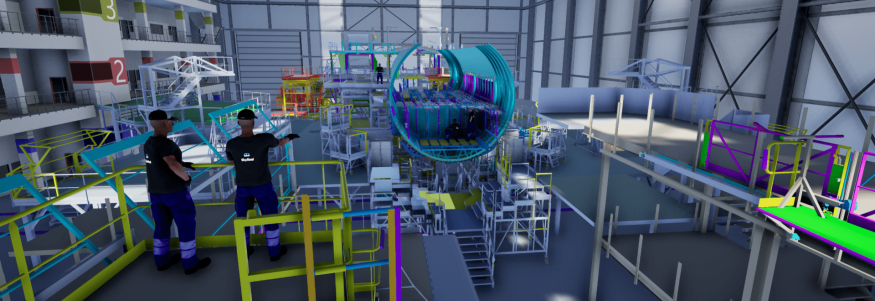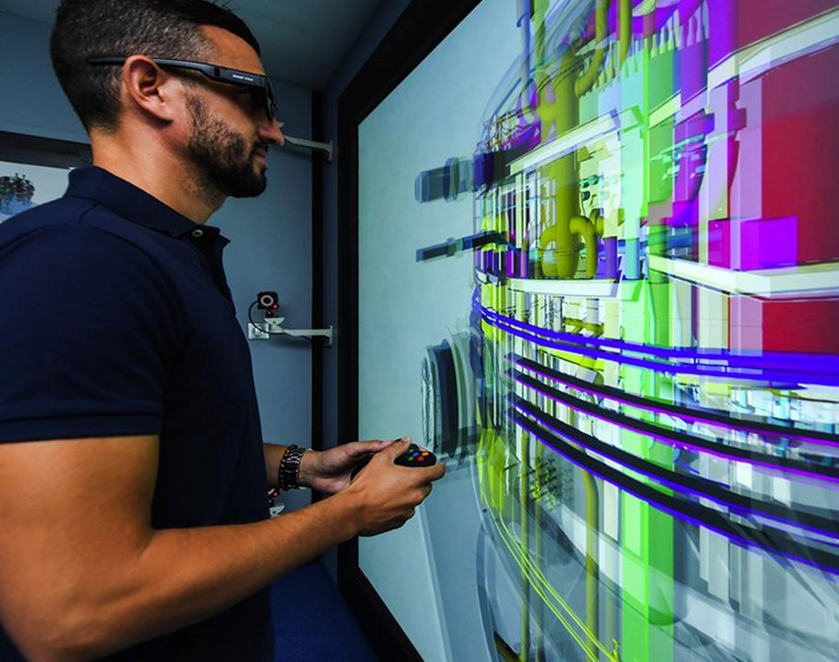Collaboration between several teams on a single project is a challenge for companies operating on an international scale. It’s often difficult to bring all the stakeholders together face-to-face: high costs, lots of travel, disrupted schedules.
Similarly, video conference meetings have shown their limits. Their over-use has led to the emergence of the “Zoom fatigue” phenomenon, which causes, among other things, a drop in motivation and a feeling of exhaustion.
At a time when well-being at work is an important issue, companies need to adopt new tools. Virtual reality (VR) is a solution for remote collaboration, particularly in industry.
Thanks to VR, employees are immersed in a shared virtual workspace, where they can visualize and manage a project in real time.
Collaborate in VR: what are the benefits for companies and teams?
VR lets you see a project in an interactive 3D simulation. Visualization, which takes place in real time and with several people, is far better than on a screen. Teams benefit from complete immersion where they can be actors, unlike a video conference where they are more often passive. Virtual reality has been proven to increase presence, even remotely.
Access to a common working environment
Virtual reality collaboration allows participants to be in the same environment, in 3D. This makes the meeting more engaging and therefore more interesting. Everyone can take part, and everyone has the same reflexes as in reality: we can talk to each other, point, move objects, annotate, draw, etc.
Virtual reality can also help with visualization. Indeed, we can recreate in 3D spaces that don’t yet exist, such as buildings under construction or prototypes. Collaborative experimentation and scenario testing are also possible at low cost.
Virtual reality collaboration in industry positively impacts production
For companies, virtual reality collaboration opens up new production possibilities and facilitates project management.
To start, remote meetings can be held more easily, avoiding the need to travel all over the world. Communication between the various parties involved in a project is also enhanced by the interactivity of 3D collaborative environments.
This has several knock-on effects:
- Barriers between teams vanished, leading to greater cohesion
- Decisions are taken more quickly, as they are discussed, visualized and corrected live
- R&D processes are accelerated, saving precious time
Stages of collaborative project management in VR
Virtual reality collaboration has many applications, at every stage of an industrial project.
Stimulate innovation and team creation
Right from the start of a project, VR meetings can be very useful, for brainstorming for example. Several scientific studies have demonstrated the effectiveness of using an immersive headset to boost brainpower and idea generation.
Improve design phases and validate hypotheses
The design phase of a project, when the customer’s needs are expressed, is a crucial stage. Virtual reality provides a better and more intuitive visualization that speaks to the customer. They can validate hypotheses and choose to add options more quickly.
Show a finalised project before it goes into production
Similarly, at the end of the project, the project can be presented to the customer in virtual reality, with similar advantages. There’s nothing like seeing the project in scale 1 to get a good idea of the final result before it goes into production.
Before going into production, manufacturers often need to carry out test phases. These validate the product design, and ensure that the equipment and software used are working properly. This is where any problems can be spotted, which is easier with virtual reality. The technology proves efficient in collective decision-making, which considerably speeds up production in general.
Carry out industrial design reviews
Of course, design reviews carried out in virtual reality have everything to gain.
These reviews take place at every stage of an industrial project, where engineers check technical and functional quality. They are a crucial point, as they enable potential malfunctions to be identified between each phase, and corrections to be made.
These reviews are carried out in a collaborative manner, hence the interest of VR, which enables interaction, annotation, exchange and modification in real time.
How to launch a business in virtual reality collaboration ?
All companies working on large-scale industrial projects have everything to gain from adopting virtual reality in their industrial processes.
SkyReal provides several solutions for implementing VR collaboration for your teams.
Skyreal VR : transforms traditional industrial production methods by integrating virtual reality
SkyReal VR is a complete solution to help you tackle immersive technologies and leverage them for your productivity.
Our software was designed for product design, maintenance and training. Today, it is used by many engineers in large companies for all aspects of design, but also for other types of work.
In particular, it can be used to collaborate in many ways:
-
- Design reviews with stakeholders (customers, manufacturing, design)
- Collaborative sessions between engineers
- Real-time design modifications
The SkyReal VR solution runs on any type of VR headset, and also for all Powerwall and CAVE.
However, with its View&Collab system, not all users need to wear an immersive headset to navigate the virtual environment during a collaborative session – they can do so easily on their computer.
What’s more, it’s also possible to run collaborative sessions with some participants in a CAVE and others in a headset or computer.
What’s more, the PiP (Picture in Picture) function allows you to put yourself as the user-host (with a VR set), so as to have his or her point of view, and thus be just as immersed without using a specific device.
XR Center : the web platform dedicated to collaboration in virtual reality
In parallel, SkyReal also provides a web platform dedicated to team collaboration.
XR Center lets you host all your virtual reality collaboration sessions and store all your XR project data.
Rooms are created for each experience to bring teams together and collaborate easily. XR Center is a powerful tool for organizing your collaborative immersive projects with optimum security.
Virtual reality in industries continues to prove its effectiveness and power for the industrial sector, and more broadly for businesses.
Professionals have everything to gain from engaging in virtual reality collaboration, which saves them time, money and strengthens team cohesion.
VR collaboration platforms open up new perspectives. They can be used to train operators remotely, in an environment that is extremely close to the real thing.




